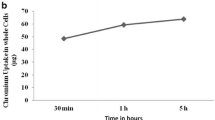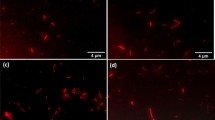Abstract
An indigenous chromate-resistant bacterial strain isolated from tannery effluent was identified based on morphological, biochemical, and 16S rRNA gene sequencing, as Enterobacter cloacae UT25. It was found to resist heavy metal ions such as Cr (VI), Pb (II), Cu (II), Co (II), Ni (II), Hg (II), and Zn (II) and antibiotics. The strain was able to remove 89 and 86% chromate, after 24 h of incubation in a Luria–Bertani (LB) medium at an initial Cr (VI) concentration of 1000 and 1500 µg/ml, respectively. Minimum inhibitory concentration (MIC) was observed for chromate to be 80,000 and 1850 µg/ml, after 48 h of incubation in LB and acetate minimal media (AMM), respectively. Scanning Electron Microscopy (SEM) and Transmission Electron Microscopy (TEM) analysis showed discrete cells with intact and smooth cell walls and homogenous cytoplasm in the absence of metal stress, whereas chromate stress caused cell lysis and reduction in size, which was a characteristic response to Cr (VI) toxicity. Energy Dispersive X-Ray Spectroscopy (EDX) confirmed the adsorption of oxyanions to the cell wall which was one of the Cr (VI) removal mechanisms by the bacterium. Atomic Force Microscopy (AFM) micrographs of chromate-untreated and treated cells revealed Root Mean Square roughness (Rq) values of 16.25 and 11.26 nm, respectively, indicating less roughness in the presence of stress. The partial gene sequence of class 1 integrons (intI1) of strain UT25 showed 94% homology with intI1 gene of strain Enterobacter hormaechei strain ECC59 plasmid pECC59-1. The present analysis highlighted the potential of E. cloacae UT25 as a promissory bacterium that could be applied in removing chromate from polluted environments.





Similar content being viewed by others
Data Availability
All data generated during this study are included in this article.
Code Availability
Not applicable.
References
Raman NM, Asokan S, Sundari NS, Ramasamy S (2018) Bioremediation of chromium (VI) by Stenotrophomonas maltophilia isolated from tannery effluent. Inter J Environ Sci Technol 15(1):207–216. https://doi.org/10.1007/s13762-017-1378-z
Das S, Behera BC, Sudarshan M, Chakraborty A, Thatoi H (2022) Bioreduction potential of chromate resistant bacteria isolated from chromite mine water of Sukinda Odisha. Bioremediat J. https://doi.org/10.1080/10889868.2029824
Sturm G, Brunner S, Suvorova E, Dempwolff F, Reiner J, Graumann P, Bernier-Latmani R, Majzlan J, Gescher J (2018) Chromate resistance mechanisms in Leucobacter chromiiresistens. Appl Environ Microbiol 84(23):e02208-e2218. https://doi.org/10.1128/AEM.02208-18
Guo S, Xiao C, Zheng Y, Li Y, Chi R (2021) Removal and potential mechanisms of Cr (VI) contamination in phosphate mining wasteland by isolated Bacillus megatherium PMW-03. J Clean Prod 322:129062. https://doi.org/10.1016/j.jclepro.2021.129062
Hossan S, Hossain S, Islam MR, Kabir MH, Ali S, Islam MS, Imran KM, Moniruzzaman M, Mou TJ, Parvez AK, Mahmud ZH (2020) Bioremediation of hexavalent chromium by chromium resistant bacteria reduces phytotoxicity. Inter J Environ Res Public Health 17(17):6013. https://doi.org/10.3390/ijerph17176013
Banerjee S, Misra A, Chaudhury S, Dam B (2019) A Bacillus strain TCL isolated from Jharia coalmine with remarkable stress responses, chromium reduction capability and bioremediation potential. J Hazard Mater 367:215–223. https://doi.org/10.1016/j.jhazmat.2018.12.038
He Z, Hu Y, Yin Z, Hu Y, Zhong H (2016) Microbial diversity of chromium-contaminated soils and characterization of six chromium-removing bacteria. Environ Manag 57(6):1319–1328. https://doi.org/10.1007/s00267-016-0675-5
Kalsoom A, Batool R, Jamil N (2021) Highly Cr (VI)-tolerant Staphylococcus simulans assisting chromate evacuation from tannery effluent. Green Process Synth 10(1):295–308. https://doi.org/10.1515/gps-2021-0027
Tamura K, Stecher G, Peterson D, Filipski A, Kumar S (2013) MEGA6: molecular evolutionary genetics analysis version 6.0. Mol Biol Evol 30(12):2725–2729. https://doi.org/10.1093/molbev/mst197
Akinbowale OL, Peng H, Grant P, Barton MD (2007) Antibiotic and heavy metal resistance in motile aeromonads and pseudomonads from rainbow trout (Oncorhynchus mykiss) farms in Australia. Inter J Antimicrob Agents 30(2):177–182. https://doi.org/10.1016/j.ijantimicag.2007.03.012
Kalsoom A, Batool R, Jamil N (2020) An integrated approach for safe removal of chromium (VI) by Brevibacterium sp. Pak J Sci 72(1):1–18
Suresh G, Balasubramanian B, Ravichandran N, Ramesh B, Kamyab H, Velmurugan P, Siva GV, Ravi AV (2021) Bioremediation of hexavalent chromium-contaminated wastewater by Bacillus thuringiensis and Staphylococcus capitis isolated from tannery sediment. Biomass Convers Biorefin 11(2):383–391. https://doi.org/10.1007/s13399-020-01259-y
Sen Y, Mutlu M (2013) Sterilization of food contacting surfaces via non-thermal plasma treatment: a model study with Escherichia coli-contaminated stainless steel and polyethylene surfaces. Food Bioprocess Technol 6(12):3295–3304. https://doi.org/10.1007/s11947-012-1007-2
Tyagi B, Gupta B, Thakur IS (2020) Biosorption of Cr (VI) from aqueous solution by extracellular polymeric substances (EPS) produced by Parapedobacter sp. ISTM3 strain isolated from Mawsmai cave, Meghalaya India. Environ Res 191:110064. https://doi.org/10.1016/j.envres.2020.110064
Ma Y, Zhong H, He Z (2019) Cr (VI) reductase activity locates in the cytoplasm of Aeribacillus pallidus BK1, a novel Cr (VI)-reducing thermophile isolated from Tengchong geothermal region, China. Chem Eng J 371:524–534. https://doi.org/10.1016/j.cej.2019.04.085
Ashayeri-Panah M, Feizabadi MM, Eftekhar F (2014) Correlation of multi-drug resistance, integron and blaESBL gene carriage with genetic fingerprints of extended-spectrum β-lactamase producing Klebsiella pneumoniae. Jundishapur J Microbiol 7(2):e8747. https://doi.org/10.5812/jjm.8747
Upadhyay N, Vishwakarma K, Singh J, Mishra M, Kumar V, Rani R, Mishra RK, Chauhan DK, Tripathi DK, Sharma S (2017) Tolerance and reduction of chromium (VI) by Bacillus sp. MNU16 isolated from contaminated coal mining soil. Front Plant Sci 8:778. https://doi.org/10.3389/fpls.2017.00778
Ramírez V, Baez A, López P, Bustillos R, Villalobos MA, Carreño R, Contreras JL, Muñoz-Rojas J, Fuentes LE, Martínez J, Munive JA (2019) Chromium hyper-tolerant Bacillus sp. MH778713 assists phytoremediation of heavy metals by mesquite trees (Prosopis laevigata). Front Microbiol 10:1833. https://doi.org/10.3389/fmicb.2019.01833
Alam MZ, Ahmad S, Malik A (2011) Prevalence of heavy metal resistance in bacteria isolated from tannery effluents and affected soil. Environ Monit Assess 178(1):281–291. https://doi.org/10.1007/s10661-010-1689-8
Koc S, Kabatas B, Icgen B (2013) Multidrug and heavy metal-resistant Raoultella planticola isolated from surface water. Bull Environ Contam Toxicol 91(2):177–183. https://doi.org/10.1007/s00128-013-1031-6
Rahman A, Nahar N, Nawani NN, Jass J, Hossain K, Saud ZA, Saha AK, Ghosh S, Olsson B, Mandal A (2015) Bioremediation of hexavalent chromium (VI) by a soil-borne bacterium, Enterobacter cloacae B2-DHA. J Environ Sci Health Part A 50(11):1136–1147. https://doi.org/10.1080/10934529.2015.1047670
Pattnaik S, Mohapatra S, Pati S, Dash D, Devadarshini D, Tanaya K, Mishra BB, Samantaray D (2022) Microbial bioremediation of Cr (VI)-contaminated soil for sustainable agriculture. Microbial Biodegradation and Bioremediation. Elsevier, Amsterdam, pp 395–407
Shi K, Dai X, Fan X, Zhang Y, Chen Z, Wang G (2020) Simultaneous removal of chromate and arsenite by the immobilized Enterobacter bacterium in combination with chemical reagents. Chemosphere 259:127428. https://doi.org/10.1016/j.chemosphere.2020.127428
Gupta P, Kumar V, Usmani Z, Rani R, Chandra A, Gupta VK (2020) Implications of plant growth promoting Klebsiella sp. CPSB4 and Enterobacter sp. CPSB49 in luxuriant growth of tomato plants under chromium stress. Chemosphere 240:124944. https://doi.org/10.1016/j.chemosphere.2019.124944
Subrahmanyam G, Sharma RK, Kumar GN, Archana G (2018) Vigna radiata var. GM4 plant growth enhancement and root colonization by a multi-metal-resistant plant growth-promoting bacterium Enterobacter sp. C1D in Cr (VI)-amended soils. Pedosphere 28(1):144–156. https://doi.org/10.1016/S1002-0160(17)60448-X
Thatoi H, Das S, Mishra J, Rath BP, Das N (2014) Bacterial chromate reductase, a potential enzyme for bioremediation of hexavalent chromium: a review. J Environ Manag 146:383–399. https://doi.org/10.1016/j.jenvman.2014.07.014
Chandra R, Bharagava RN, Kapley A, Purohit HJ (2011) Bacterial diversity, organic pollutants and their metabolites in two aeration lagoons of common effluent treatment plant (CETP) during the degradation and detoxification of tannery wastewater. Bioresour Technol 102(3):2333–2341. https://doi.org/10.1016/j.biortech.2010.10.087
Wang Y, Yang Z, Peng B, Chai L, Wu B, Wu R (2013) Biotreatment of chromite ore processing residue by Pannonibacter phragmitetus BB. Environ Science Pollut Res 20(8):5593–5602. https://doi.org/10.1007/s11356-013-1526-z
Pavithra KG, Kumar PS, Christopher FC, Saravanan A (2017) Removal of toxic Cr (VI) ions from tannery industrial wastewater using a newly designed three-phase three-dimensional electrode reactor. J Phys Chem Solids 110:379–385. https://doi.org/10.1016/j.jpcs.2017.07.002
Li L, Shang X, Sun X, Xiao X, Xue J, Gao Y, Gao H (2021) Bioremediation potential of hexavalent chromium by a novel bacterium Stenotrophomonas acidaminiphila 4–1. Environ Technol Innov 22:101409. https://doi.org/10.1016/j.eti.2021.101409
Bai Y-N, Lu Y-Z, Shen N, Lau T-C, Zeng RJ (2018) Investigation of Cr (VI) reduction potential and mechanism by Caldicellulosiruptor saccharolyticus under glucose fermentation condition. J Hazard Mater 344:585–592. https://doi.org/10.1016/j.jhazmat.2017.10.059
Rewak-Soroczynska J, Dorotkiewicz-Jach A, Drulis-Kawa Z, Wiglusz R (2022) Culture media composition influences the antibacterial effect of silver, cupric, and zinc ions against Pseudomonas aeruginosa. Biomolecules 12(7):963–978. https://doi.org/10.3390/biom12070963
Oladipo OG, Awotoye OO, Olayinka A, Ezeokoli OT, Maboeta MS, Bezuidenhout CC (2016) Heavy metal tolerance potential of Aspergillus strains isolated from mining sites. Bioremediat J 20(4):287–297. https://doi.org/10.1080/10889868.2016.1250722
Biswas J, Bose P, Mandal S, Paul AK (2018) Reduction of hexavalent chromium by a moderately halophilic bacterium, Halomonas smyrnensis KS802 under saline environment. Environ Sustain 1(4):411–423. https://doi.org/10.1007/s42398-018-00037-x
Rizvi A, Ahmed B, Zaidi A, Khan M (2019) Bioreduction of toxicity influenced by bioactive molecules secreted under metal stress by Azotobacter chroococcum. Ecotoxicol 28(3):302–322. https://doi.org/10.1007/s10646-019-02023-3
Zeng W, Li F, Wu C, Yu R, Wu X, Shen L, Liu Y, Qiu G, Li J (2020) Role of extracellular polymeric substance (EPS) in toxicity response of soil bacteria Bacillus sp. S3 to multiple heavy metals. Bioprocess Biosyst Eng 43(1):153–167. https://doi.org/10.1007/s00449-019-02213-7
Karthik C, Barathi S, Pugazhendhi A, Ramkumar VS, Thi NBD, Arulselvi PI (2017) Evaluation of Cr (VI) reduction mechanism and removal by Cellulosimicrobium funkei strain AR8, a novel haloalkaliphilic bacterium. J Hazard Mater 333:42–53. https://doi.org/10.1016/j.jhazmat.2017.03.037
Fernández M, Morales GM, Agostini E, González PS (2017) An approach to study ultrastructural changes and adaptive strategies displayed by Acinetobacter guillouiae SFC 500–1A under simultaneous Cr (VI) and phenol treatment. Environ Sci Pollut Res 24(25):20390–20400. https://doi.org/10.1007/s11356-017-9682-1
Batool R, Yrjälä K, Shaukat K, Jamil N, Hasnain S (2015) Production of EPS under Cr (VI) challenge in two indigenous bacteria isolated from a tannery effluent. J Basic Microbiol 55(9):1064–1074. https://doi.org/10.1002/jobm.201400885
Wu S, Altenried S, Zogg A, Zuber F, Maniura-Weber K, Ren Q (2018) Role of the surface nanoscale roughness of stainless steel on bacterial adhesion and microcolony formation. ACS Omega 3(6):6456–6464. https://doi.org/10.1021/acsomega.8b00769
Sabbagh P, Rajabnia M, Maali A, Ferdosi-Shahandashti E (2021) Integron and its role in antimicrobial resistance: a literature review on some bacterial pathogens. Iran J Basic Med Sci 24(2):136–142. https://doi.org/10.22038/ijbms.2020.48905.11208
Sultan I, Rahman S, Jan AT, Siddiqui MT, Mondal AH, Haq QMR (2018) Antibiotics, resistome and resistance mechanisms: a bacterial perspective. Front Microbiol 9:2066. https://doi.org/10.3389/fmicb.2018.02066
Deng Y, Bao X, Ji L, Chen L, Liu J, Miao J, Chen D, Bian H, Li Y, Yu G (2015) Resistance integrons: class 1, 2 and 3 integrons. Ann Clin Microbiol Anti 14(1):1–11. https://doi.org/10.1186/s12941-015-0100-6
Gang H, Xiao C, Xiao Y, Yan W, Bai R, Ding R, Yang Z, Zhao F (2019) Proteomic analysis of the reduction and resistance mechanisms of Shewanella oneidensis MR-1 under long-term hexavalent chromium stress. Environ Inter 127:94–102. https://doi.org/10.1016/j.envint.2019.03.016
Ahemad M (2015) Enhancing phytoremediation of chromium-stressed soils through plant-growth promoting bacteria. J Genet Eng Biotechnol 13(1):51–58. https://doi.org/10.1016/j.jgeb.2015.02.001
Acknowledgements
We appreciate University of the Punjab for supporting the present study. This research work is part of the Ph.D. Thesis of the first author Ms. Asma Kalsoom.
Funding
This research did not receive any specific grant from funding agencies in the public, commercial, or nonprofit sectors.
Author information
Authors and Affiliations
Contributions
AK: data curation, formal analysis, investigation, methodology, software, visualization, and writing—original draft; RB & NJ: conceptualization, data curation, formal analysis, methodology, project administration, resources, software, supervision, validation, visualization, and writing—review & editing; SMH and JAK: performed and interpretation of AFM data. All authors read and approved the final manuscript.
Corresponding author
Ethics declarations
Conflict of interest
The authors declare that they have no conflicting interests.
Ethical Approval
This article does not contain any studies with human participants or animals.
Consent for Publication
Not applicable.
Consent to Participate
Not applicable.
Additional information
Publisher's Note
Springer Nature remains neutral with regard to jurisdictional claims in published maps and institutional affiliations.
Rights and permissions
Springer Nature or its licensor (e.g. a society or other partner) holds exclusive rights to this article under a publishing agreement with the author(s) or other rightsholder(s); author self-archiving of the accepted manuscript version of this article is solely governed by the terms of such publishing agreement and applicable law.
About this article
Cite this article
Kalsoom, A., Jamil, N., Hassan, S.M.u. et al. Chromate Removal by Enterobacter cloacae Strain UT25 from Tannery Effluent and Its Potential Role in Cr (VI) Remediation. Curr Microbiol 80, 99 (2023). https://doi.org/10.1007/s00284-023-03194-3
Received:
Accepted:
Published:
DOI: https://doi.org/10.1007/s00284-023-03194-3




